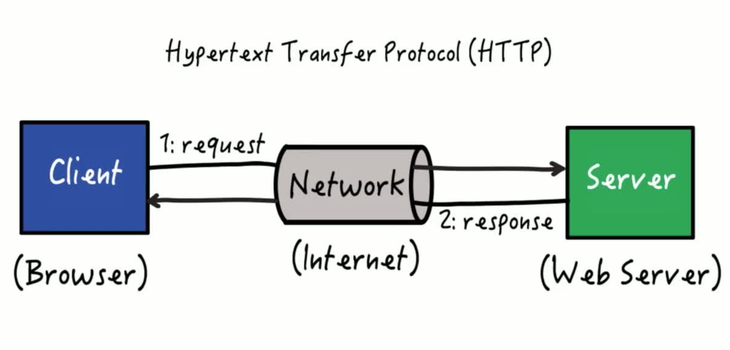The Hypertext Transfer Protocol (HTTP)
HTTP Protocol
The HyperText Transfer Protocol (HTTP) is the foundation for data communication on the Web, and it involves request/resonse interactions:

HTTP is an application layer protocol used to deliver resources in distributed hypermedia information system. In a Web application, the request initiates activities that are implemented over the middleware. and the response typically involves returning resources to the browser.
In order to build and debug web applications, it is vital to have a good understand of how HTTP works.
HTTP - Resources
The resources delivered as part of this protocol typically include hypertext, marked up using the HyperText Markup Language (HTML), cascading style sheets (CSS), hypermedia and scripts
- Hypertext – text that can be displayed on a computer, or other display device, possibly styled with CSS, and containing references (i.e., hyperlinks) to other hypertext that the reader is able to immediately access, usually via a mouse click.
- Hypermedia – the logical extension of hypertext to graphics, audio and video.
- Hyperlinks – define a structure over the Web. Indeed, this is the structure that Google uses to determine the relevance of hyperlinks that are returned to you by a search.
- Scripts – code that can be executed on the client side.
HTTP - Background
The HTTP protocol is extremely lightweight and simple – indeed, that’s one of the main reasons for its success.
Initially, with HTTP/0.9 (the first documented HTTP protocol), a client could only issue GET requests, asking a server for a resource.
Ex.
GET /welcome.htmlwill cause the server to return the contents of the requested file (the response was required to be HTML).
The HTTP/1.0 protocol, introduced in 1996, extended HTTP/0.9 to include request headers along with additional request methods.
The HTTP/1.1 extension followed soon thereafter, and included the following improvements:
- Faster response, by allowing multiple transactions to take place over a single persistent connection.
- Faster response and bandwidth savings, by adding cache support.
- Faster response for dynamically-generated content, by supporting chunked encoding, which allows a response to be sent before its total length is known.
- Efficient use of IP addresses, multiple domains can be served from a single IP address.
- Support for proxies.
- Support for content negotiations.
HTTP/2 is the next second major protocol update after HTTP 1.1. It has been published in 2015 and brought several performance improvements:
- Data compression of HTTP headers.
- Added new server push technologies.
- Pipelining the requests.
- The possibility to send multiple parallel requests over a single TCP connection.
HTTP - Basic
- HTTP has always been a stateless protocol.
- This refers to the fact that the protocol does not require the server to retain information related to previous client requests.
- Thus, each client request is executed independently, without any knowledge of the client requests that preceded it.
- This made if very difficult for web applications to respond intelligently to user input, i.e., to create the interactivity that users expect when they use computer applications.
- Cookies, sessions, URL encoded parameters and a few other technologies have been introduced to address this issue, thereby allowing for the emergence of Web 2.0 and 3.0 applications.
HTTP - Sessions
An HTTP session proceeds as follows:
- Step 1: An HTTP client (e.g., a browser) establishes a TCP connection to a particular port on a host server (typically this is port 80), and initiates a request. Establishing the TCP connection may first involve using an DNS server in order to obtain an IP Address.
- Step 2: An HTTP server listening on that port waits for a client’s request message.
- Step 3: Upon receiving the request, the server processes it and sends back a status line, such as "HTTP/1.1 200 OK", along with a message of its own (i.e., a response), the body of which might be a requested resource, an error message, or some other information.
In addition to using browser developer tools, you can also directly explore how a web server responds to client requests using telnet:

- This tells the server that you (the client) are making an HTTP GET request, asking for the file index.html.
- Hit <return>, and the HTML associated with the resource will be provided.
Latest Post
- Dependency injection
- Directives and Pipes
- Data binding
- HTTP Get vs. Post
- Node.js is everywhere
- MongoDB root user
- Combine JavaScript and CSS
- Inline Small JavaScript and CSS
- Minify JavaScript and CSS
- Defer Parsing of JavaScript
- Prefer Async Script Loading
- Components, Bootstrap and DOM
- What is HEAD in git?
- Show the changes in Git.
- What is AngularJS 2?
- Confidence Interval for a Population Mean
- Accuracy vs. Precision
- Sampling Distribution
- Working with the Normal Distribution
- Standardized score - Z score
- Percentile
- Evaluating the Normal Distribution
- What is Nodejs? Advantages and disadvantage?
- How do I debug Nodejs applications?
- Sync directory search using fs.readdirSync